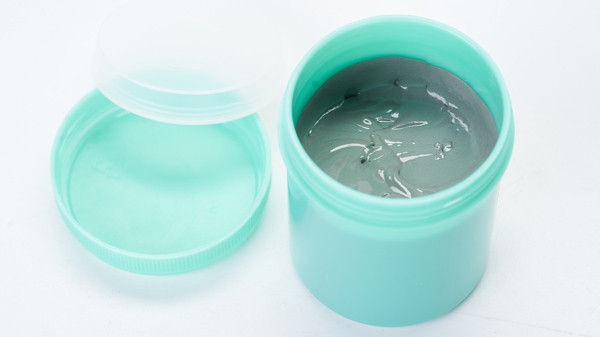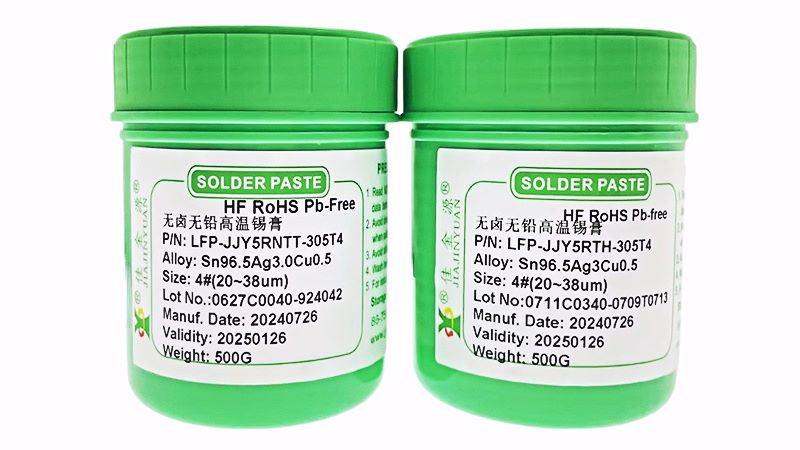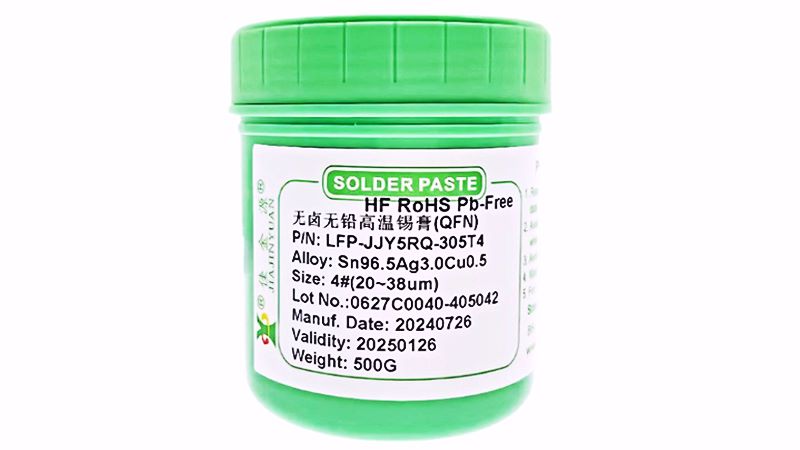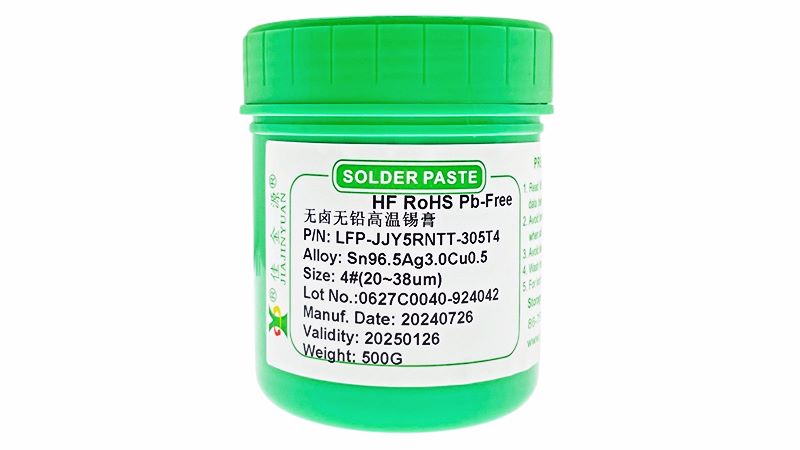Today's social development is more diverse. Many industries have high requirements for products and functions. Many manufacturers want to ensure and meet customers' demands. However, this is not an easy task. If manufacturers want to meet the requirements of many products, they must improve quality. In response to this phenomenon, inSMTWelding is an indispensable part. We often say that the quality of a product lies in the first step. There are many problems that are prone to occur during the processing to avoid soldering. Have you paid attention to these details? Now, JJY Solder Paste Manufacturer will explain them to you:

The first factor includes:
1The heating rate is too fast;
2The thixotropic property of the solder paste is too poor or the viscosity of the solder paste recovers too slowly after shearing.
3The metal load or solid content is too low;
4The particle size distribution of the powder is too wide.
5The surface tension of the flux is too small. However, slump does not necessarily cause incomplete soldering. During soft melting, the melted incomplete solder may break under the push of surface tension, and the loss of solder will make the incomplete soldering problem even more serious. In this case, the excessive solder accumulated in a certain area due to solder loss will cause the molten solder to become too abundant and difficult to break. In addition to the factors that cause solder paste to collapse, the following factors are also common causes of incomplete soldering:
1Too much solder paste is deposited compared to the space between the solder joints.
2The heating temperature is too high;
3The solder paste heats up faster than the circuit board.
4The wetting speed of the flux is too fast.
5The vapor pressure of the flux is too low.
6; The solvent content of the flux is too high.
7The softening point of the flux resin is too low.
Intermittent wetting of the solder film refers to the presence of water on a smooth surface.1.4.5.This is because solder can adhere to the surface of most solid metals, and there are some unwetted points hidden beneath the melted solder coating. Therefore, when the surface is initially covered with melted solder, intermittent wetting occurs. The metastable molten solder coating will contract under the action of the minimum surface energy driving force, and after a short while, it will aggregate into separated small spheres and ridge-like aggregates. Intermittent wetting can also be caused by the gas released when the component comes into contact with the molten solder. The moisture released due to the thermal decomposition of organic matter or the hydration of inorganic matter will all produce gas. Water vapor is the most common component of these related gases. At the welding temperature, water vapor has a very strong oxidizing effect and can oxidize the surface of the molten solder film or certain interfaces beneath the surface (a typical example is the surface of metal oxides at the interface of molten solder). A common situation is that higher welding temperatures and longer residence times can lead to more severe intermittent wetting phenomena, especially in the base metal, where the increase in reaction rate will cause more intense gas release.
Meanwhile, a longer residence time will also prolong the time for gas release. Both of the above aspects will increase the amount of gas released. The method to eliminate the intermittent wetting phenomenon is:
1Reduce the welding temperature;
2Shorten the residence time of the soft melt;
3Adopt a flowing inert atmosphere;
4Reduce the degree of pollution.
Low residue
For soft-melt processes that do not require cleaning, low residue is often required to achieve decorative or functional effects. Examples of functional requirements include "Detect the test surfacing layer through the flux residue tested in the circuit and perform electrical contact between the insert joint and the surfacing layer or between the insert joint and the through hole near the soft melt welding point." A large amount of flux residue often leads to excessive residue coverage on the metal surface layer where electrical contact is to be performed, which hinders the establishment of the electrical connection. With the increasing circuit density, this problem has drawn more and more attention from people.
Obviously, low-residue solder paste that does not require cleaning is an ideal solution to meet this requirement. However, the necessary conditions for soft melting related to this have made this issue even more complicated. To predict the welding performance of low-residue solder paste in inert soft-melt atmospheres of different levels, a semi-empirical model is proposed. This model predicts that with the decrease of oxygen content, the welding performance will improve rapidly and then gradually stabilize. The experimental results show that with the decrease of oxygen concentration, the welding strength and the wetting ability of the solder paste will increase. In addition, The welding strength also increases with the increase of the solid content in the flux. The model proposed by the experimental data is comparable and strongly proves that the model is effective and can be used to predict the welding performance of solder paste and materials. Therefore, it can be asserted that in order to successfully use low-residue solder that does not require cleaning in the welding process, an inert soft melt atmosphere should be used.
Gap refers to the absence of a solder joint between the component leads and the solder joints on the circuit board. Generally speaking, this can be attributed to the following four reasons:
1Insufficient solder deposition;
2Poor coplanarity of leads;
3Insufficient wetting;
4Solder loss is caused by the collapse of solder paste on the pre-tinned printed circuit board and the core suction effect of the leads.2.3.4It is caused by a through hole near the solder joint,The problem of coplanarity of leads is new and lighter in weight12MillμmPitch four-core wire flat integrated circuit(QFPjujubeQuad flatpacks)A particularly concerning issue,In order to solve this problem,A method of pre-coating solder joints with solder before assembly was proposed(9),This method involves expanding the size of the local solder joint and forming a controllable local solder zone along the bulging solder pre-covered area,And thereby compensate for the change of coplanarity of the leads and prevent clearances,The core suction effect of the lead wire can be solved by slowing down the heating rate and allowing the bottom surface to be heated more than the top surface,In addition,Use flux with a slower wetting speed,Higher activation temperature or solder paste that can delay melting(Solder paste mixed with tin powder and lead powder)It can also minimize the core suction effect to the greatest extent.Before finishing the circuit board with a tin-lead coating,Covering the connection path with a solder mask can also prevent core attraction caused by nearby through holes.
Solder spheroidization is the most common and intractable problem, which refers to the fact that in the soft melting process, the solder solidifies into spheroidization particles of different sizes not far from the main solder molten pool. In most cases,These spheroids are composed of solder powder in the solder paste. The formation of solder spheroids has raised concerns about potential problems such as short circuits, leakage, and insufficient solder at the welding points. With the advancement of micro-pitch technology and welding methods that do not require cleaning, there is an increasingly urgent need for the use of solder spheroid solutionsSMTCraftsmanship.
Cause the solder to form balls1,2,4,10The reasons include:
1Oil stains caused by improper circuit printing process;
2The solder paste was overly exposed to an oxidizing environment;
3The solder paste was overly exposed to a humid environment;
4Improper heating methods;
5The heating speed is too fast;
6,The preheating section is too long;
7The interaction between solder mask and solder paste;
8The flux activity is insufficient;
9Excessive oxide or contamination of welding powder;
10There are too many dust particles;
11In a specific soft-melt treatment,Inappropriate volatile substances were mixed into the flux;
12Solder slump caused by improper solder paste formulation;
13The solder paste was opened and used before it was fully restored to room temperature.
14Excessive printing thickness causes "collapse" and forms tin balls.
15The metal content in the solder paste is relatively low.
The above is an explanation for everyoneSMTSolder pasteSome situations may occur during welding. Everyone should try to understand them. This is not a sufficient reason and there may be more situations. We need to study and discuss them ourselves. If you still have any questions, you can come to consult Shenzhen JJY Industrial Technology Co., LTD. Let's learn and grow together!





 Tel:+86 0755 88366766
Tel:+86 0755 88366766 Phone:+86 18938660310
Phone:+86 18938660310 Email:sales@jjyhanxi.com
Email:sales@jjyhanxi.com Address:13/F,12/F, Building No. B,Qinghu Technology Park,Qingxiang Rd.,Qinghu Community, Longhua Subdistrict,Longhua District,Shenzhen City,GUANGDONG Province,P.R.C.(518027)
Address:13/F,12/F, Building No. B,Qinghu Technology Park,Qingxiang Rd.,Qinghu Community, Longhua Subdistrict,Longhua District,Shenzhen City,GUANGDONG Province,P.R.C.(518027) Guangdong Public Security Backup 44030902002666 name
Guangdong Public Security Backup 44030902002666 name
 WeChat
WeChat WeChat official account
WeChat official account
